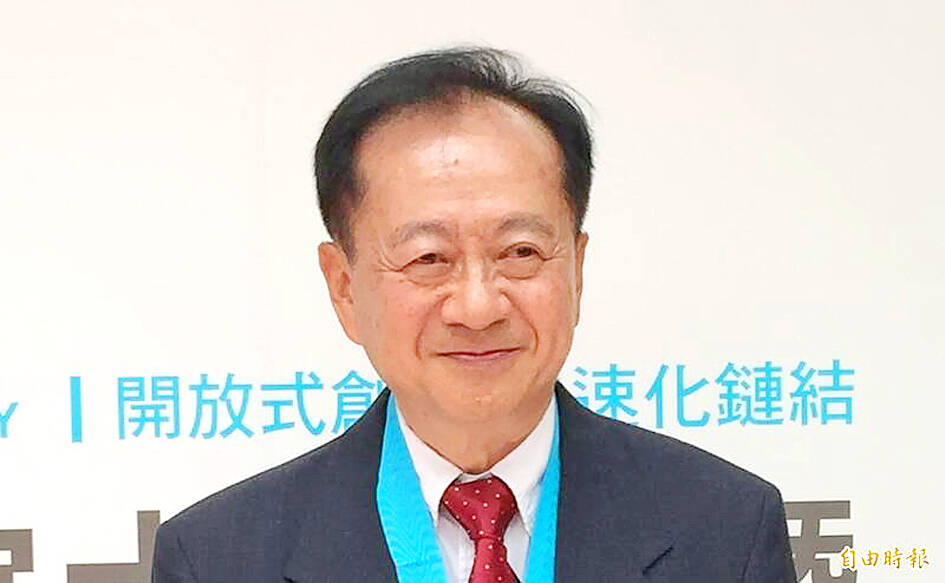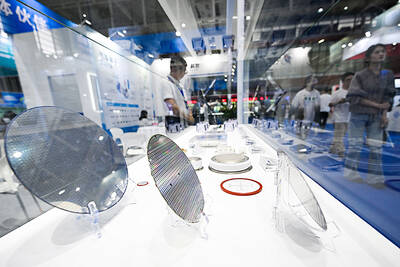The struggles of China’s chip industry predate US sanctions, and “people” are the country’s “biggest hurdle,” former Taiwan Semiconductor Manufacturing Co (TSMC, 台積電) co-chief operating officer Chiang Shang-yi (蔣尚義) said in an interview.
Speaking on Era TV’s Taiwan Insights on Sunday, Chiang, who worked in China for several years after leaving TSMC in 2013, said that while Chinese firms might be capable of solving the technical aspects of research and development, he found during his time there that “the biggest hurdle was always people.”
Regarding his dealings with “political leaders” when serving as vice chairman of Shanghai-based Semiconductor Manufacturing International Corp (SMIC, 中芯國際), Chiang said he felt that he was “not trusted.”

Photo: Grace Hung, Taipei Times
“SMIC is headquartered in Shanghai, but has factories in Beijing. I was asked by then-SMIC chairman Zhou Zixue (周子學) to fly to Beijing when a high-ranking official wished to visit the factories, but twice I was shut out of the meetings because they only allowed People’s Republic of China citizens to attend,” Chiang said.
Zhou had tried to iron out the issue by setting up personal meetings with the Beijing official for Chiang, but “it was not a pleasant feeling,” he said.
With regards to US sanctions against Beijing, Chiang said they would slow down the development of China’s chip industry, but it remained to be seen if the pressure would end up forcing chipmakers to stand on their own feet.
“We do not know whether self-reliance could be achieved [in China’s semiconductor industry], but one also has to note that China has been developing the industry for more than 10 years and the US sanctions are actually very recent,” Chiang said.
China’s chip industry was “not that successful either when it was not restricted,” he added.
Chiang was first recruited by SMIC, China’s top foundry, as an independent director in 2016, before leaving to take up the position of CEO at Wuhan Hongxin Semiconductor Corp (HSMC, 武漢弘芯) in 2019.
He left HSMC in July 2020 and returned to SMIC in mid-December 2020 to take over as vice chairman, but left China a year later.
After leaving SMIC in 2021, he told local media in Taiwan that he would not work in China again.
Chiang in November last year joined Hon Hai Precision Industry Co (鴻海精密) as its chief strategy officer to integrate the resources of its semiconductor subsidiaries. In June, he was appointed to chair ShunSin Technology Holdings Ltd (訊芯科技), a semiconductor arm of Hon Hai that specializes in offering system-in-a-package modules and optical transceivers.
Additional reporting by Lisa Wang

Taiwan’s exports soared 56 percent year-on-year to an all-time high of US$64.05 billion last month, propelled by surging global demand for artificial intelligence (AI), high-performance computing and cloud service infrastructure, the Ministry of Finance said yesterday. Department of Statistics Director-General Beatrice Tsai (蔡美娜) called the figure an unexpected upside surprise, citing a wave of technology orders from overseas customers alongside the usual year-end shopping season for technology products. Growth is likely to remain strong this month, she said, projecting a 40 percent to 45 percent expansion on an annual basis. The outperformance could prompt the Directorate-General of Budget, Accounting and

The demise of the coal industry left the US’ Appalachian region in tatters, with lost jobs, spoiled water and countless kilometers of abandoned underground mines. Now entrepreneurs are eyeing the rural region with ambitious visions to rebuild its economy by converting old mines into solar power systems and data centers that could help fuel the increasing power demands of the artificial intelligence (AI) boom. One such project is underway by a non-profit team calling itself Energy DELTA (Discovery, Education, Learning and Technology Accelerator) Lab, which is looking to develop energy sources on about 26,305 hectares of old coal land in

Netflix on Friday faced fierce criticism over its blockbuster deal to acquire Warner Bros Discovery. The streaming giant is already viewed as a pariah in some Hollywood circles, largely due to its reluctance to release content in theaters and its disruption of traditional industry practices. As Netflix emerged as the likely winning bidder for Warner Bros — the studio behind Casablanca, the Harry Potter movies and Friends — Hollywood’s elite launched an aggressive campaign against the acquisition. Titanic director James Cameron called the buyout a “disaster,” while a group of prominent producers are lobbying US Congress to oppose the deal,

Two Chinese chipmakers are attracting strong retail investor demand, buoyed by industry peer Moore Threads Technology Co’s (摩爾線程) stellar debut. The retail portion of MetaX Integrated Circuits (Shanghai) Co’s (上海沐曦) upcoming initial public offering (IPO) was 2,986 times oversubscribed on Friday, according to a filing. Meanwhile, Beijing Onmicro Electronics Co (北京昂瑞微), which makes radio frequency chips, was 2,899 times oversubscribed on Friday, its filing showed. The bids coincided with Moore Threads’ trading debut, which surged 425 percent on Friday after raising 8 billion yuan (US$1.13 billion) on bets that the company could emerge as a viable local competitor to Nvidia